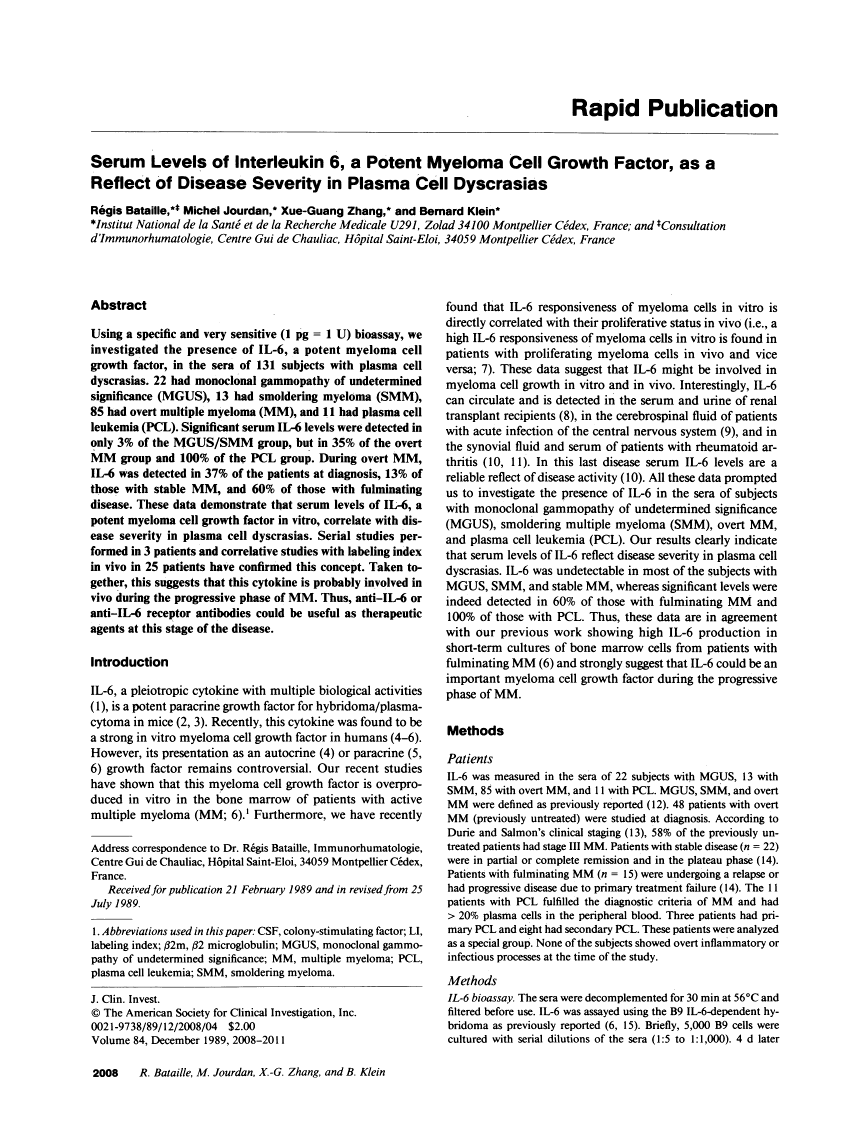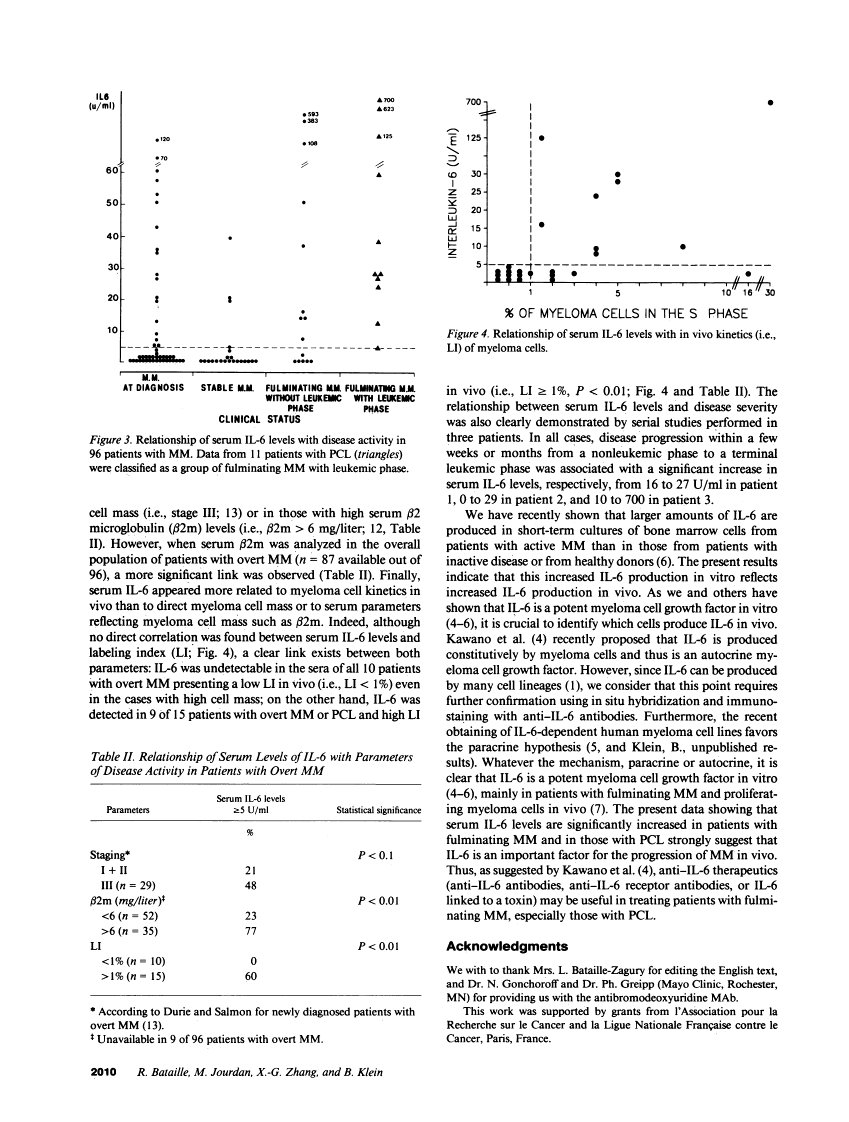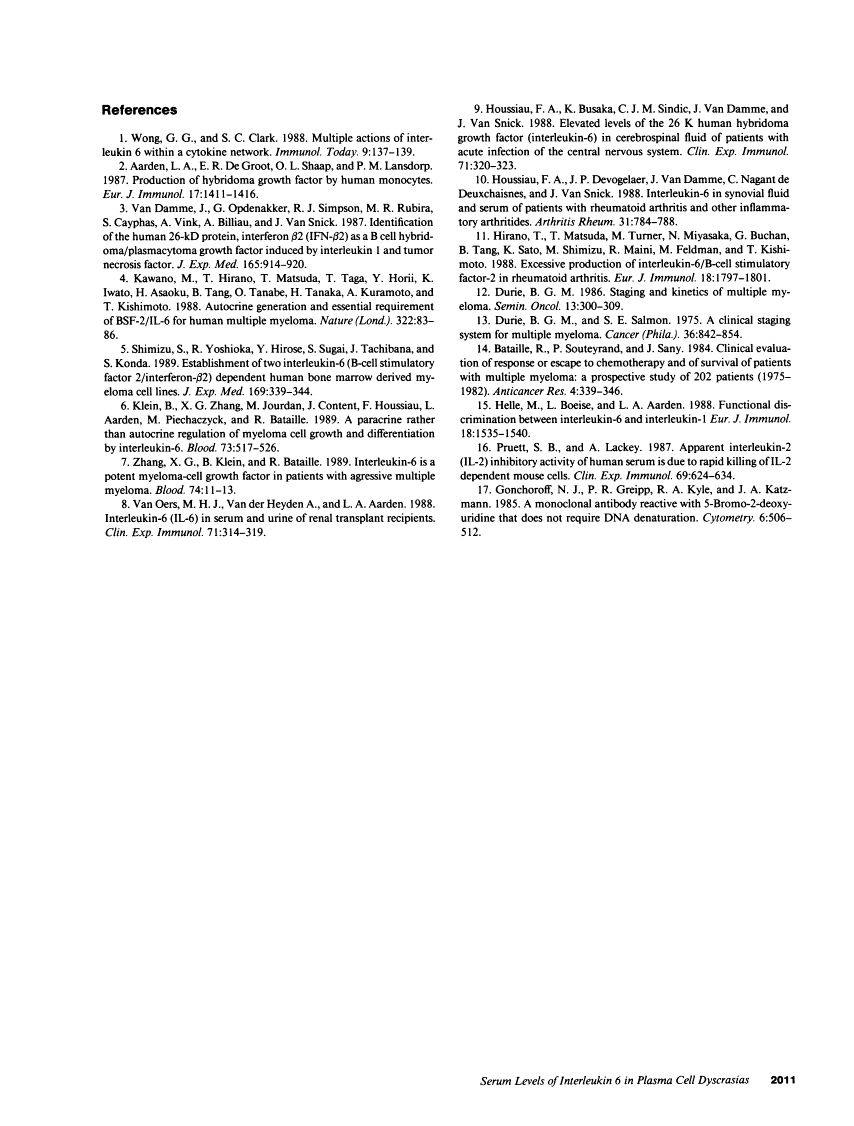Abstract
Free full text

Serum levels of interleukin 6, a potent myeloma cell growth factor, as a reflect of disease severity in plasma cell dyscrasias.
Abstract
Using a specific and very sensitive (1 pg = 1 U) bioassay, we investigated the presence of IL-6, a potent myeloma cell growth factor, in the sera of 131 subjects with plasma cell dyscrasias. 22 had monoclonal gammopathy of undetermined significance (MGUS), 13 had smoldering myeloma (SMM), 85 had overt multiple myeloma (MM), and 11 had plasma cell leukemia (PCL). Significant serum IL-6 levels were detected in only 3% of the MGUS/SMM group, but in 35% of the overt MM group and 100% of the PCL group. During overt MM, IL-6 was detected in 37% of the patients at diagnosis, 13% of those with stable MM, and 60% of those with fulminating disease. These data demonstrate that serum levels of IL-6, a potent myeloma cell growth factor in vitro, correlate with disease severity in plasma cell dyscrasias. Serial studies performed in 3 patients and correlative studies with labeling index in vivo in 25 patients have confirmed this concept. Taken together, this suggests that this cytokine is probably involved in vivo during the progressive phase of MM. Thus, anti-IL-6 or anti-IL-6 receptor antibodies could be useful as therapeutic agents at this stage of the disease.
Full text
Full text is available as a scanned copy of the original print version. Get a printable copy (PDF file) of the complete article (647K), or click on a page image below to browse page by page. Links to PubMed are also available for Selected References.
Selected References
These references are in PubMed. This may not be the complete list of references from this article.
- Wong GG, Clark SC. Multiple actions of interleukin 6 within a cytokine network. Immunol Today. 1988 May;9(5):137–139. [Abstract] [Google Scholar]
- Aarden LA, De Groot ER, Schaap OL, Lansdorp PM. Production of hybridoma growth factor by human monocytes. Eur J Immunol. 1987 Oct;17(10):1411–1416. [Abstract] [Google Scholar]
- Van Damme J, Opdenakker G, Simpson RJ, Rubira MR, Cayphas S, Vink A, Billiau A, Van Snick J. Identification of the human 26-kD protein, interferon beta 2 (IFN-beta 2), as a B cell hybridoma/plasmacytoma growth factor induced by interleukin 1 and tumor necrosis factor. J Exp Med. 1987 Mar 1;165(3):914–919. [Europe PMC free article] [Abstract] [Google Scholar]
- Shimizu S, Yoshioka R, Hirose Y, Sugai S, Tachibana J, Konda S. Establishment of two interleukin 6 (B cell stimulatory factor 2/interferon beta 2)-dependent human bone marrow-derived myeloma cell lines. J Exp Med. 1989 Jan 1;169(1):339–344. [Europe PMC free article] [Abstract] [Google Scholar]
- Klein B, Zhang XG, Jourdan M, Content J, Houssiau F, Aarden L, Piechaczyk M, Bataille R. Paracrine rather than autocrine regulation of myeloma-cell growth and differentiation by interleukin-6. Blood. 1989 Feb;73(2):517–526. [Abstract] [Google Scholar]
- Zhang XG, Klein B, Bataille R. Interleukin-6 is a potent myeloma-cell growth factor in patients with aggressive multiple myeloma. Blood. 1989 Jul;74(1):11–13. [Abstract] [Google Scholar]
- Van Oers MH, Van der Heyden AA, Aarden LA. Interleukin 6 (IL-6) in serum and urine of renal transplant recipients. Clin Exp Immunol. 1988 Feb;71(2):314–319. [Abstract] [Google Scholar]
- Houssiau FA, Bukasa K, Sindic CJ, Van Damme J, Van Snick J. Elevated levels of the 26K human hybridoma growth factor (interleukin 6) in cerebrospinal fluid of patients with acute infection of the central nervous system. Clin Exp Immunol. 1988 Feb;71(2):320–323. [Abstract] [Google Scholar]
- Houssiau FA, Devogelaer JP, Van Damme J, de Deuxchaisnes CN, Van Snick J. Interleukin-6 in synovial fluid and serum of patients with rheumatoid arthritis and other inflammatory arthritides. Arthritis Rheum. 1988 Jun;31(6):784–788. [Abstract] [Google Scholar]
- Hirano T, Matsuda T, Turner M, Miyasaka N, Buchan G, Tang B, Sato K, Shimizu M, Maini R, Feldmann M, et al. Excessive production of interleukin 6/B cell stimulatory factor-2 in rheumatoid arthritis. Eur J Immunol. 1988 Nov;18(11):1797–1801. [Abstract] [Google Scholar]
- Durie BG. Staging and kinetics of multiple myeloma. Semin Oncol. 1986 Sep;13(3):300–309. [Abstract] [Google Scholar]
- Durie BG, Salmon SE. A clinical staging system for multiple myeloma. Correlation of measured myeloma cell mass with presenting clinical features, response to treatment, and survival. Cancer. 1975 Sep;36(3):842–854. [Abstract] [Google Scholar]
- Bataille R, Souteyrand P, Sany J. Clinical evaluation of response or escape to chemotherapy and of survival of patients with multiple myeloma. A prospective study of 202 patients (1975-1982). Anticancer Res. 1984 Nov-Dec;4(6):339–345. [Abstract] [Google Scholar]
- Helle M, Boeije L, Aarden LA. Functional discrimination between interleukin 6 and interleukin 1. Eur J Immunol. 1988 Oct;18(10):1535–1540. [Abstract] [Google Scholar]
- Pruett SB, Lackey A. Apparent interleukin 2 (IL-2) inhibitory activity of human serum is due to rapid killing of IL-2-dependent mouse cells. Clin Exp Immunol. 1987 Sep;69(3):624–631. [Abstract] [Google Scholar]
- Gonchoroff NJ, Greipp PR, Kyle RA, Katzmann JA. A monoclonal antibody reactive with 5-bromo-2-deoxyuridine that does not require DNA denaturation. Cytometry. 1985 Nov;6(6):506–512. [Abstract] [Google Scholar]
Associated Data
Articles from The Journal of Clinical Investigation are provided here courtesy of American Society for Clinical Investigation
Full text links
Read article at publisher's site: https://doi.org/10.1172/jci114392
Read article for free, from open access legal sources, via Unpaywall:
http://www.jci.org/articles/view/114392/files/pdf
Citations & impact
Impact metrics
Citations of article over time
Alternative metrics
Smart citations by scite.ai
Explore citation contexts and check if this article has been
supported or disputed.
https://scite.ai/reports/10.1172/jci114392
Article citations
Optimal cut-off values and diagnostic significance of clinical laboratory indicators in newly diagnosed multiple myeloma.
Discov Oncol, 15(1):477, 27 Sep 2024
Cited by: 0 articles | PMID: 39331239 | PMCID: PMC11436520
Descriptive analysis and prognostic factors in cats with myeloma-related disorders: A multicenter retrospective study of 50 cases.
J Vet Intern Med, 38(3):1693-1705, 22 Mar 2024
Cited by: 1 article | PMID: 38517293 | PMCID: PMC11099758
Combined detection of serum IL-6 and CEA contributes to the diagnosis of lung adenocarcinoma in situ.
PeerJ, 12:e17141, 22 Mar 2024
Cited by: 1 article | PMID: 38529301 | PMCID: PMC10962332
Changes in RDW according to prognostic predictors in newly diagnosed multiple myeloma.
Sci Rep, 14(1):2832, 03 Feb 2024
Cited by: 0 articles | PMID: 38310176 | PMCID: PMC10838310
The Clinical Relevance of Selected Cytokines in Newly Diagnosed Multiple Myeloma Patients.
Biomedicines, 11(11):3012, 09 Nov 2023
Cited by: 1 article | PMID: 38002012 | PMCID: PMC10669681
Go to all (260) article citations
Similar Articles
To arrive at the top five similar articles we use a word-weighted algorithm to compare words from the Title and Abstract of each citation.
Cytokines (IL-6, TNF-alpha, IL-1alpha) and soluble interleukin-2 receptor as serum tumor markers in multiple myeloma.
Cancer Detect Prev, 20(1):52-56, 01 Jan 1996
Cited by: 31 articles | PMID: 8907203
A contribution to examination of propidium iodide and annexin V plasma cells indices in multiple myeloma.
Neoplasma, 50(5):363-371, 01 Jan 2003
Cited by: 2 articles | PMID: 14628090
High serum interleukin-2 levels in patients with monoclonal gammopathy of undetermined significance (MGUS) and multiple myeloma.
Nouv Rev Fr Hematol (1978), 31(5):329-332, 01 Jan 1989
Cited by: 2 articles | PMID: 2587201
A review of the cytokine network in multiple myeloma: diagnostic, prognostic, and therapeutic implications.
Cancer, 97(10):2440-2452, 01 May 2003
Cited by: 140 articles | PMID: 12733143
Review









